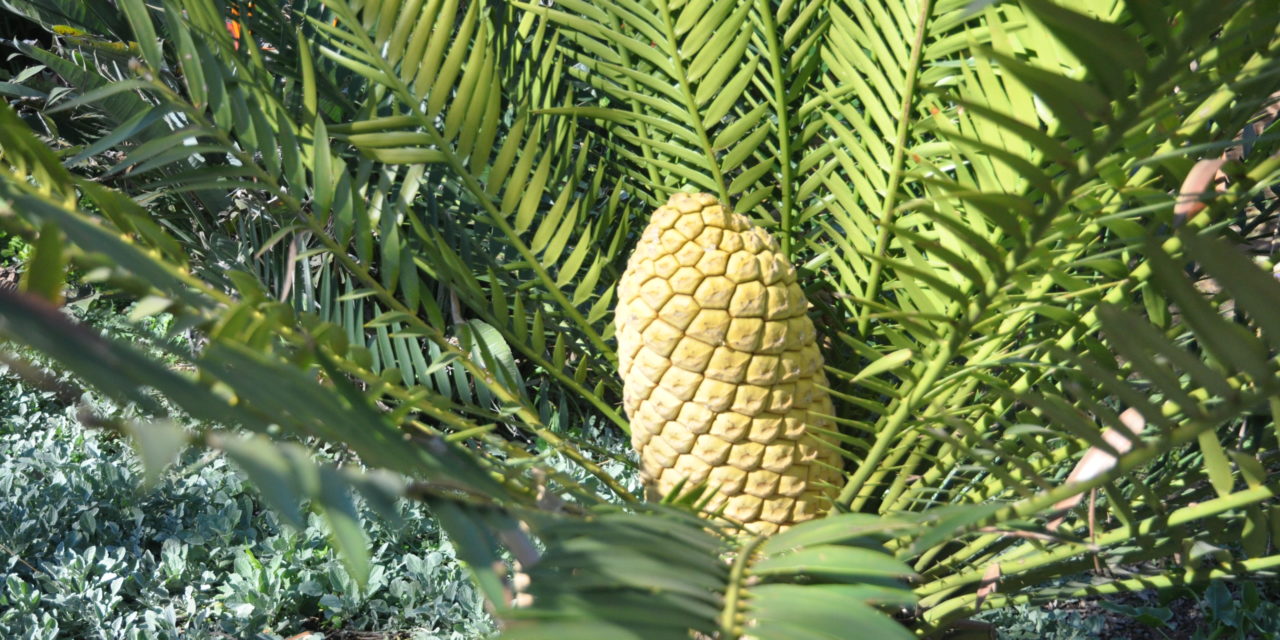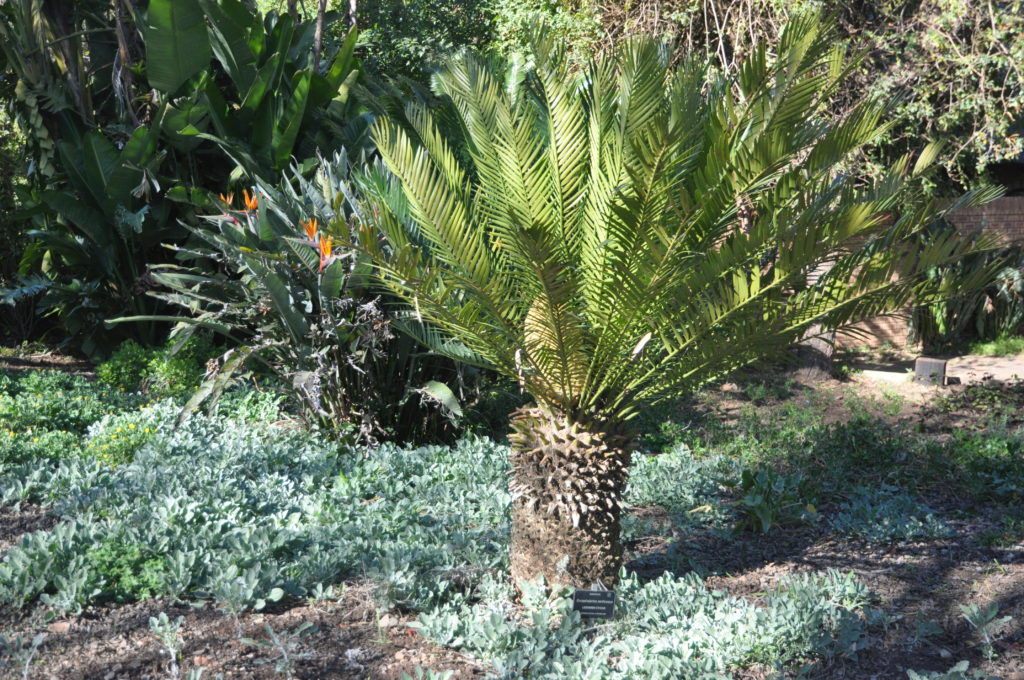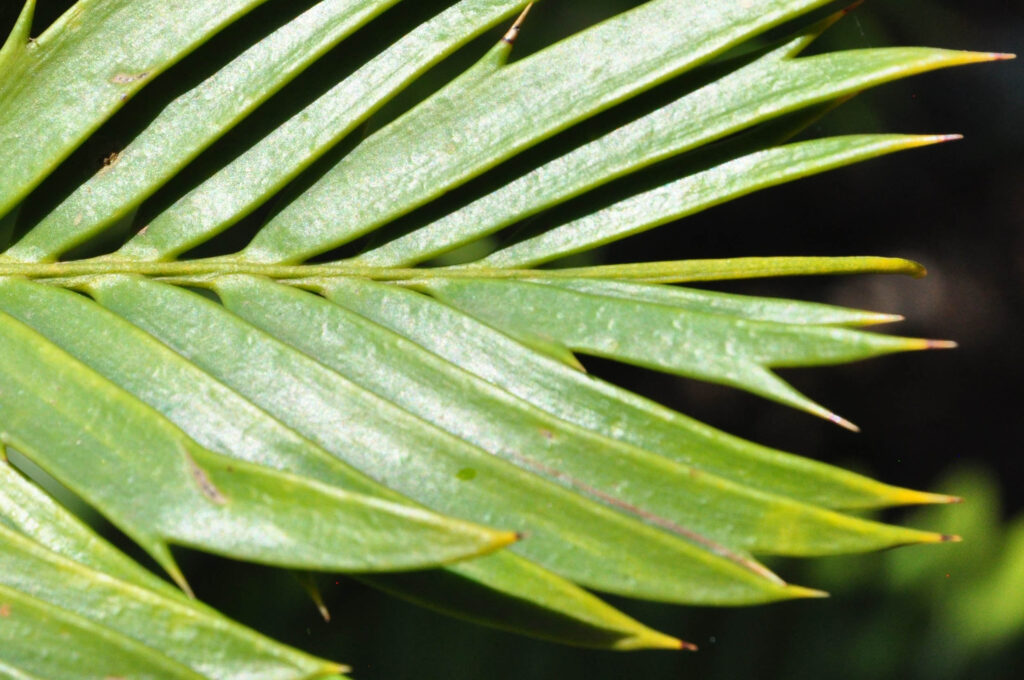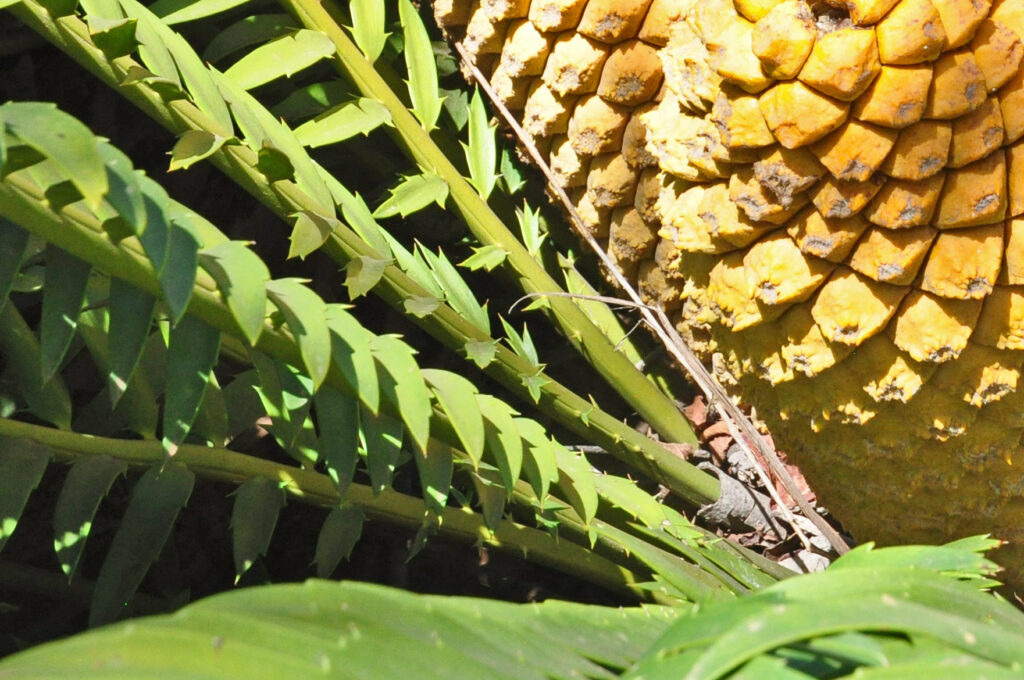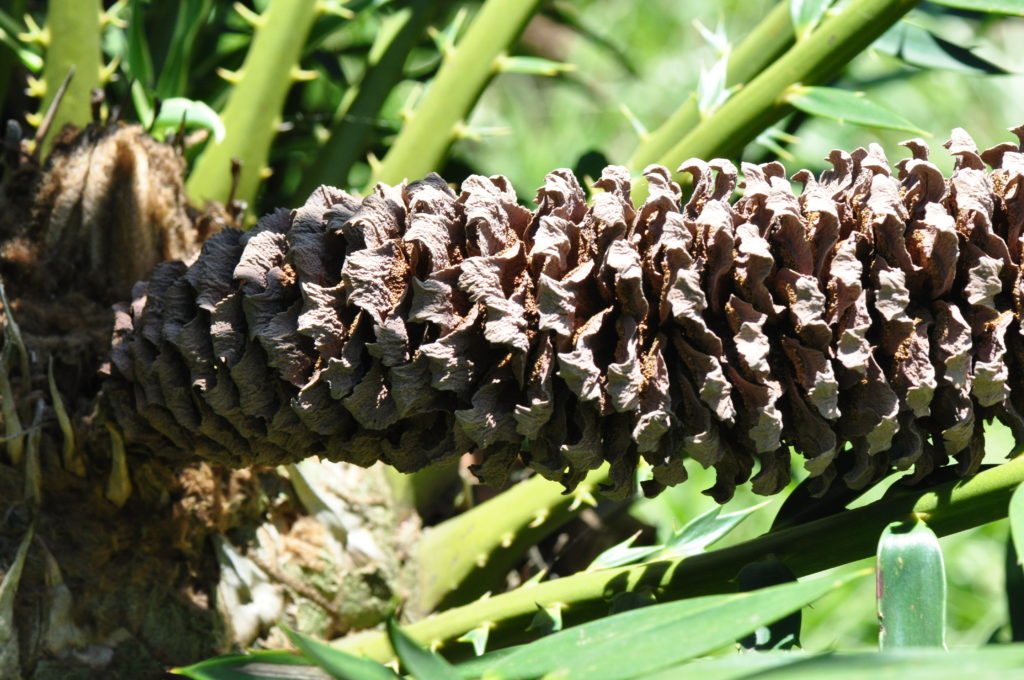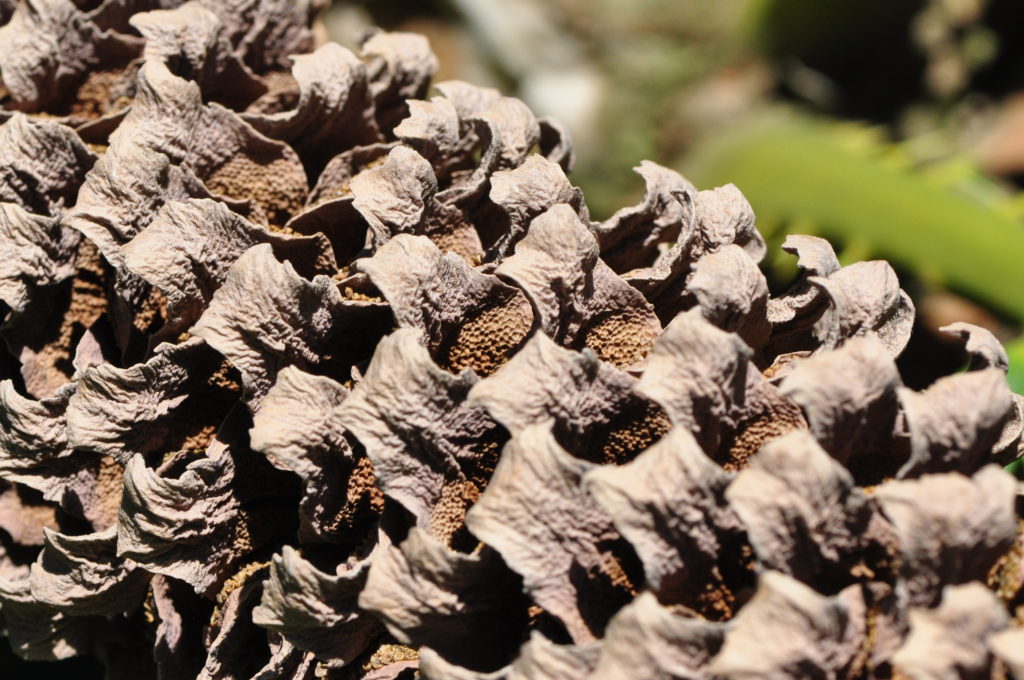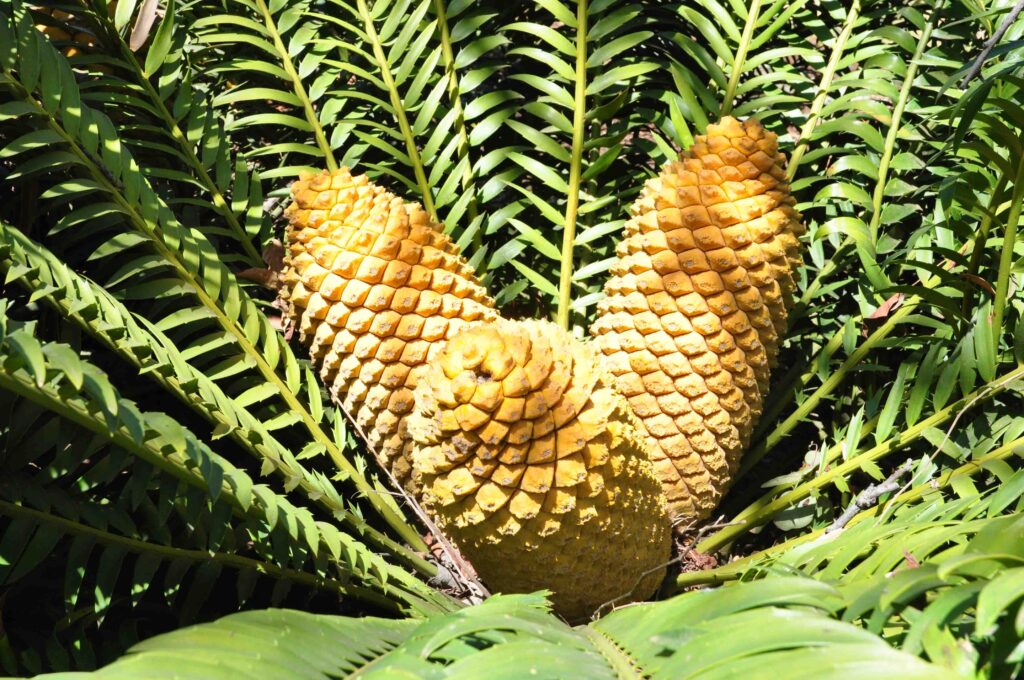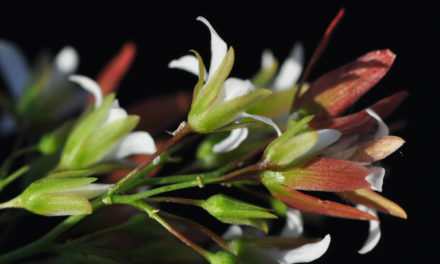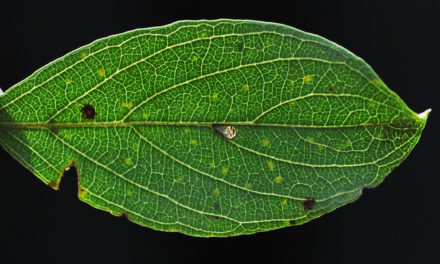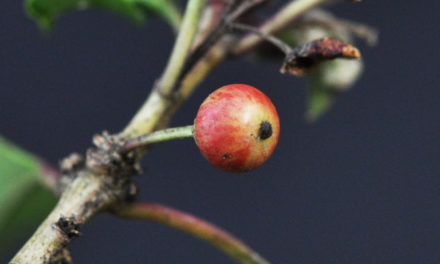General Info – summary
This dioecious Tree may be multi-stemmed and is up to 4m high with a trunk up to 30cm wide. Pinnately compound Leaves are up to 1,8m long. The spiny leaflets near the base are reduced to prickles. The 1-4 Male Cones have motile sperms. The 1-3 larger yellow, stalked Female Cones are up to 45 x 22cm. The poisonous, naked Seeds are scarlet and released when the mature female cone disintegrates downwards.
Description
Encephalartos senticosus
Previous Name: Encephalartos lebomboensis.
SA Tree No. 8.
Common names: (Afr) Jozini-broodboom, Lebombo-broodboom. (Eng) Cycad, Jozini Cycad, Lebombo Cycad. (isiZulu) Ijubane, Isidwaba-somkhovu, Isigqiki-semkhovu, Isigqiki-somkhovu, Ujubane. (siSwati) Sijekwane.
Family: Zamiaceae. This family is part of the major group: Gymnosperms. Zamiaceae are usually cone-bearing plants producing naked seeds and include Ginkgo (in China), Cycads, Conifers (e.g., pine trees) and Gnetophytes: e.g., the unique Welwitschia mirabilis (tweeblaarkanniedood) are not wind pollinated and found in the deserts of western Namibia and southern Angola. Members of the gymnosperm family Zamiaceae have no flowers or fruit and the seeds are often contained in Cones. This family has 8 genera, including the Genus Encephalartos, which contains all species of cycads.
Name derivation: Encephalartos – within-head-bread: referring to the starchy bread that can be made from the pith of the inner trunk. senticosus – spiny: referring to the leaflets. All cycads fall into the genus Encephalartos, which includes some of the most primitive living gymnosperms. The African plants in the genus Encephalartos include about 66 species and about 35 species occur in southern Africa.
Conservation: National Status: V U. (Vulnerable). Assessment: 2009. J.D. Bosenberg. The population trend is decreasing. This is mainly due to illegal harvesting.
Tree
Species of Encephalartos (Cycads) are only superficially palm or fern like and are usually unbranched. The cycad tap Root is usually soon replaced by lateral roots, which become woody.
This robust Cycad is woody; almost palm-like and may be erect or tilted. The Trunk may reach 4m high and 30cm wide. The remains of petioles (leaf bases) are visible only near the trunk apex (photo 431). These do eventually fall, only leaving visible leaf scars towards the base of the trunk. Up to 8 stems may be present. The Crown is only slightly woolly. The tree may sucker from the base forming clumps.
- 431. 2018/07/25. Walter Sisulu NBG. Photo: David Becking.
Leaves
Cycads are unique gymnosperms having pinnately compound Leaves (leaflets arranged along either side of the leaf rachis, the central stalk, like a feather). Cycads have evergreen, dark green, glossy leaves that are parallel veined. Unlike other members of the family Zamiaceae, the cycads have leaflets that lack a central Midrib (vein). The hard leaflets do not bend easily. Stomata (structure utilising 2 guard cells that, unlike lenticels, can control gaseous exchange) are present.
Leaves of Encephalartos senticosus are up to 1,8m long, straight or slightly recurved and are persistent (lasting longer than 1 year). Petioles (stalks that attach the leaf blades to the stem) are up to 10cm long and do remain on the tree for a while after the blades have fallen (photo 431 under Tree). The hard central Leaflets are up to 18cm x 2,2cm. They are narrowly oblong and have a long tapering apex (photo 431 under Tree). The central opposing leaflets are at an angle of about 135 degrees from each other across the Rachis (main axis bearing the leaflets). The Margins on both sides may be serrated (photo 295). The centre leaflets are the widest and decrease progressively in size towards the leaf base, where the lowermost leaflets are reduced to spines (photo 297).
- 295. 2019/10/08. Pretoria NBG. Photo: David Becking.
- 297. 2019/10/08. Pretoria NBG. Photo: David Becking.
Cones
Gymnosperms have unenclosed or naked seeds. They have no flowers or fruit and the seeds are often contained in cones. In the Angiosperms (flowering plants), the seeds are enclosed in an ovary. In the Gymnosperms, there are 2 modes of fertilization. In all the Cycads (including Encephalartos) and the single extant (not extinct) species of Ginkgo biloba, the male cones produce motile sperms which do not move along a pollen tube. The remaining members of the Gymnosperms all have non-motile sperm with no flagella and are moved along via a Pollen tube to the egg. All Cycads are Dioecious (having male and female cones on separate plants). These cones develop in the centre of the leaf whorls.
In Encephalartos senticosus, stalked male and female cones are initially light brown to brownish-orange and have a felt-like covering. The 3 to 4 mature Male Cones may reach 15cm x 5cm. Here Pollen develops in orange-to orange-yellow cones and is shed from April to May. Thereafter the now open cones turn brown (photo 800). In this photo, the pollen has already been shed from the lower sides of the cone scales. Up to 3 large, ovoid to barrel shaped, pale to bright apricot-yellow Female Cones develop on a separate plant (photo 293). Each is up to 45cm x 26cm. These stalked cones have a rough outer surface and are beetle pollinated. After fertilization, the Mature female cones disintegrate downwards releasing up to 590 scarlet and fairly smooth Seeds. (Sep-Oct).
- 796 2015/11/15 Male cone. Walter Sisulu NBG. Photo: David Becking.
- 800. 2015/11/15 Male cone. Walter Sisulu NBG. Photo: David Becking.
- 293. 2019/10/08. Pretoria NBG. Photo: David Becking.
Distribution & Ecology
Cycads have Coralloid Roots that contain symbiotic cyanobacteria (blue-green algae) that fix atmospheric nitrogen. Through a process of complex biological pathways, the cyanobacteria convert atmospheric molecular nitrogen into compounds such as ammonia, and amino acids needed by the cycads.
This plant is Endemic in southern Africa (endemic – restricted to a particular geographic location). The Trees are common on sunny, steep and rough hillsides, dry shrub-land, and sunny cliffs (300-800m altitude). Plants occur naturally from the Pongola River in KwaZulu-Natal, northwards along the Lebombo Mountains (800km long from Hluhluwe in Kwa-Zulu in the south, and northwards to Punda Maria in North East Mpumalanga). They also occur to the northeast of Siteki (small town on the cliff edge of East-central Eswatini (Swaziland) and in southern Mozambique. The fairly smooth Seeds are collected by birds, monkeys, rodents, baboons and even bats. The outer covering is consumed, and the remaining seeds are discarded – and thus dispersed.
Ethnobotany
Permits are necessary in order to keep this plant. These Trees are relatively fast growing and are frost resistant. Plants need a warm place in semi-shade or full sun. Trees should be planted in well-drained soil – best on a slope. All seeds produce carcinogenic and neurotoxic glycosides (cycasins). These are poisonous to mammals – including man. N.B. Use gloves when handling the seeds. After being released from the female cone, the seeds take about a year to germinate. Trees also do well as pot-plants.
References
Boon, R. 2010. Pooley’s Trees of eastern South Africa. Flora and Fauna Publications Trust, Durban.
Bosenberg, J.D. 2009. Encephalartos senticosus Vorster. National Assessment: Red List of South African Plants version 2020.1. Accessed on 2023/04/26.
Burrows, J.E., Burrows, S.M., Lotter, M.C. & Schmidt, E. Trees and Shrubs Mozambique. Publishing Print Matters (Pty) Ltd. Noordhoek, Cape Town.
Coates Palgrave, M. 2002. Keith Coates Palgrave Trees of Southern Africa, edn 3. Struik, Cape Town.
Lawrence, G. H. M, 1951. Taxonomy of Vascular Plants. The Macmillan Company, New York. Tenth Printing 1965.
Palmer, E. & Pitman, N. 1972. Trees of southern Africa, Balkema, Amsterdam, Cape Town.
van Wyk, B. & van Wyk, P. 1997 Field guide to Trees of Southern Africa, Struik, Cape Town.
https://en.wikipedia.org/wiki/Encephalartos_senticosus
http://plantzafrica.com/plantefg/encephsenti.htm
http://pza.sanbi.org/encephalartos-senticosus
http://www.cycad.org/documents/descriptions/Encephalartos/Encephalartos-senticosus.pdf
http://biodiversityadvisor.sanbi.org/wp-content/uploads/sanbi-identify-it/plants/encephalartos.htm
http://www.theplantlist.org/browse/G/Zamiaceae/
https://www.diffen.com/difference/Angiosperms_vs_Gymnosperms

